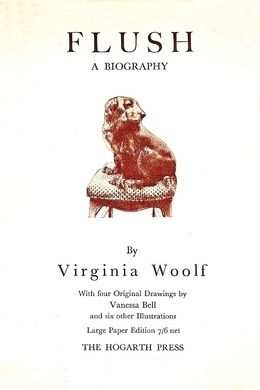
-
EPUB 169 KB
-
Kindle 210 KB
-
Support epubBooks by making a small $2.99 PayPal donation purchase.
This work is available for countries where copyright is Life+70 or less.
Description
Virginia Woolf’s humorous biography of Elizabeth Barrett Browning’s spaniel is charming yet also radical. A work of sensuous imagination, it opens up a range of questions about class, society, and cultural attitudes which are woven throughout the whole of Woolf’s writing.
125 pages with a reading time of ~2 hours (31363 words), and first published in 1933. This DRM-Free edition published by epubBooks, 2014.
Community Reviews
-
Well-researched, a major complement to the autobiographical Barretts of Wimpole Street and anthropomorphology at the finest level.
Aug 27
Excerpt
It is universally admitted that the family from which the subject of this memoir claims descent is one of the greatest antiquity. Therefore it is not strange that the origin of the name itself is lost in obscurity. Many million years ago the country which is now called Spain seethed uneasily in the ferment of creation. Ages passed; vegetation appeared; where there is vegetation the law of Nature has decreed that there shall be rabbits; where there are rabbits, Providence has ordained there shall be dogs. There is nothing in this that calls for question, or comment. But when we ask why the dog that caught the rabbit was called a Spaniel, then doubts and difficulties begin. Some historians say that when the Carthaginians landed in Spain the common soldiers shouted with one accord “Span! Span!”–for rabbits darted from every scrub, from every bush. The land was alive with rabbits. And Span in the Carthaginian tongue signifies Rabbit. Thus the land was called Hispania, or Rabbit-land, and the dogs, which were almost instantly perceived in full pursuit of the rabbits, were called Spaniels or rabbit dogs. There many of us would be content to let the matter rest; but truth compels us to add that there is another school of thought which thinks differently. The word Hispania, these scholars say, has nothing whatever to do with the Carthaginian word span. Hispania derives from the Basque word españa, signifying an edge or boundary. If that is so, rabbits, bushes, dogs, soldiers–the whole of that romantic and pleasant picture, must be dismissed from the mind; and we must simply suppose that the Spaniel is called a spaniel because Spain is called España. As for the third school of antiquaries which maintains that just as a lover calls his mistress monster or monkey, so the Spaniards called their favourite dogs crooked or cragged (the word españa can be made to take these meanings) because a spaniel is notoriously the opposite–that is too fanciful a conjecture to be seriously entertained. Passing over these theories, and many more which need not detain us here, we reach Wales in the middle of the tenth century. The spaniel is already there, brought, some say, by the Spanish clan of Ebhor or Ivor many centuries previously; and certainly by the middle of the tenth century a dog of high repute and value. “The Spaniel of the King is a pound in value,” Howel Dda laid down in his Book of Laws. And when we remember what the pound could buy in the year A.D. 948–how many wives, slaves, horses, oxen, turkeys and geese–it is plain that the spaniel was already a dog of value and reputation. He had his place already by the King’s side. His family was held in honour before those of many famous monarchs. He was taking his ease in palaces when the Plantagenets and the Tudors and the Stuarts were following other people’s ploughs through other people’s mud. Long before the Howards, the Cavendishes or the Russells had risen above the common ruck of Smiths, Joneses and Tomkins, the Spaniel family was a family distinguished and apart. And as the centuries took their way, minor branches broke off from the parent stem. By degrees, as English history pursues its course, there came into existence at least seven famous Spaniel families–the Clumber, the Sussex, the Norfolk, the Black Field, the Cocker, the Irish Water and the English Water, all deriving from the original spaniel of prehistoric days but showing distinct characteristics, and therefore no doubt claiming privileges as distinct. That there was an aristocracy of dogs by the time Queen Elizabeth was on the throne Sir Philip Sidney bears witness: “…greyhounds, Spaniels and Hounds,” he observes, “whereof the first might seem the Lords, the second the Gentlemen, and the last the Yeomen of dogs,” he writes in the Arcadia.
